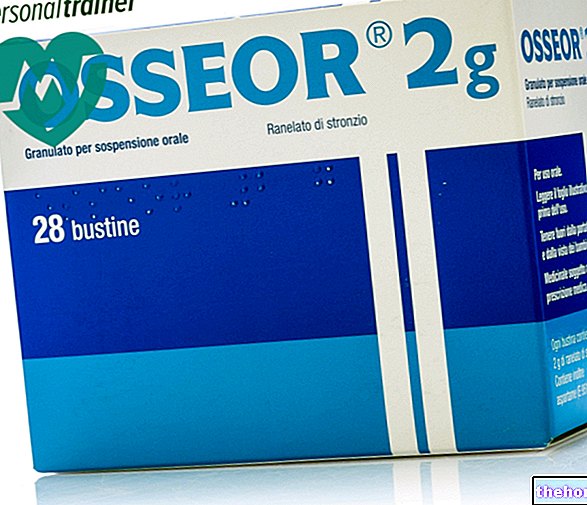Active ingredients: Melatonin
Circadin 2 mg prolonged-release tablets
Why is Circadin used? What is it for?
The active ingredient in Circadin, melatonin, belongs to a group of natural hormones produced by the body.
Circadin is used on its own for the short-term treatment of primary insomnia (persistent difficulty falling asleep or staying asleep or poor sleep quality) in patients aged 55 years and older. "Primary" means no cause has been identified. for insomnia, including a medical, mental or environmental cause.
Contraindications When Circadin should not be used
Do not take Circadin
- if you are allergic to melatonin or any of the other ingredients of this medicine (listed in section 6).
Precautions for use What you need to know before taking Circadin
Talk to your doctor or pharmacist before taking Circadin.
- if you have liver or kidney problems. No studies have been conducted on the use of Circadin in people with liver or kidney disease; talk to your doctor before taking Circadin, as its use is not recommended.
- if your doctor has told you that you have an "intolerance to some sugars.
- if you have been told that you have an autoimmune disease (where the body is "attacked" by its own immune system). Circadin has not been studied in people with autoimmune diseases, so check with your doctor before taking Circadin , as its use is not recommended.
- Circadin can cause drowsiness; be careful if you feel drowsy, as this can impair your abilities in activities such as driving vehicles.
- Smoking may reduce the effectiveness of Circadin, as the components of tobacco smoke are able to increase the transformation of melatonin by the liver.
Children and adolescents
Do not give this medicine to children between the ages of 0 and 18 as it has not been tested and its effects are not known.
Interactions Which drugs or foods can change the effect of Circadin
Tell your doctor or pharmacist if you are taking, have recently taken or might take any other medicines. Such medicines include:
- Fluvoxamine (used to treat depression and obsessive-compulsive disorder), psoralen (used to treat skin conditions e.g. psoriasis (reddish, scaly patches of the skin), cimetidine (used to treat stomach problems, such as ulcers) , quinolones and rifampicin (used to treat bacterial infections), estrogen (used in contraceptives or in hormone replacement therapy) and carbamazepine (used to treat epilepsy).
- Adrenergic agonists / antagonists (such as some types of medicines used to control blood pressure by narrowing blood vessels, nasal decongestants, medicines to lower blood pressure), opioid agonists / antagonists (such as medicines used to treat drug addiction), prostaglandin inhibitors (such as non-steroidal anti-inflammatory drugs), antidepressants, tryptophan and alcohol.
- Benzodiapines and non-benzodiazepine hypnotics (medicines used to induce sleep, such as zaleplon, zolpidem and zopiclone).
- Thioridazine (for the treatment of schizophrenia) and imipramine (for the treatment of depression).
Circadin with food, drink and alcohol
Take Circadin after eating. Do not consume alcohol before, during or after taking Circadin, as it reduces the effectiveness of Circadin.
Warnings It is important to know that:
Pregnancy and breastfeeding
Do not take Circadin if you are pregnant, think you may be pregnant or are planning to become pregnant, or if you are breast-feeding. Ask your doctor or pharmacist for advice before taking this medicine.
Driving and using machines
Circadin can cause drowsiness. In this case, you should not drive or operate machinery. If you experience prolonged sleepiness, please contact your doctor
Circadin contains lactose monohydrate
Circadin contains lactose monohydrate. If you have been told by your doctor that you have an intolerance to some sugars, talk to your doctor before taking this medicine.
Dose, Method and Time of Administration How to use Circadin: Posology
Always take this medicine always exactly as your doctor or pharmacist has told you. If in doubt, consult your doctor or pharmacist.
The recommended dose is one Circadin tablet (2 mg) to be taken by mouth each day after a meal, 1-2 hours before bedtime. This dosage can be maintained for up to thirteen weeks.
The tablet should be swallowed whole. Circadin tablets should not be crushed or cut in half.
Overdose What to do if you have taken too much Circadin
If you take more Circadin than you should
If you have accidentally taken too much of the medicine, contact your doctor or pharmacist as soon as possible.
If you have taken more than the maximum recommended dose of medicine, you may feel drowsy.
If you forget to take Circadin
If you forget to take a tablet, either take it as soon as you notice it, before going to bed, or wait for the next dose, then carry on as usual.
Do not take a double dose to make up for a forgotten dose.
If you stop taking Circadin
There are no known harmful effects in the event of interruption or premature discontinuation of treatment. There are no known symptoms of Circadin discontinuation after completion of therapy.
If you have any further questions on the use of this medicine, ask your doctor or pharmacist.
Side Effects What are the side effects of Circadin
Like all medicines, this medicine can cause side effects, although not everybody gets them.
If you suffer from any of the following serious side effects, stop taking the medicine and contact your doctor immediately:
Uncommon: (may affect up to 1 in 100 people)
- Chest pain
Rare: (may affect up to 1 in 1,000 people)
- Loss of consciousness or fainting
- Severe chest pain caused by angina
- Noticeable heartbeats Depression
- Alteration (including reduction) of vision
- Blurred vision
- Disorientation
- Vertigo (feeling of dizziness)
- Presence of red blood cells in the urine
- Reduced number of white blood cells in the blood
- Reduction in platelets, resulting in increased bleeding or bruising
- Psoriasis (reddish, scaly patches of skin)
If you get any of the following non-serious side effects, talk to your doctor and / or get medical advice:
Uncommon: (may affect up to 1 in 100 people)
Irritability, nervousness, restlessness, insomnia, abnormal dreams, nightmares, anxiety, migraines, headaches, lethargy (tiredness, lack of energy), restlessness associated with "increased activity, dizziness, tiredness, hypertension, upper abdominal pain, indigestion, mouth ulceration, dry mouth, nausea, change in blood composition which may cause yellow skin or eyes, inflammation of the skin, night sweats, itching, rash, dry skin, pain in extremities, symptoms of menopause, sensation weakness, the presence of glucose in the urine, excess protein in the urine, abnormal liver function tests and weight gain.
Rare: (may affect up to 1 in 1,000 people) Herpes zoster (St. Anthony's Fire), increased blood fat levels, low serum calcium levels, low blood sodium levels, mood changes, aggression, agitation, crying, stress symptoms, early morning awakening, increased libido (increased sexual desire), mood depression, memory impairment, attention disorder, dream state, restless legs syndrome, poor quality sleep, feeling tingling, lacrimation increased, postural dizziness (vertigo when standing or sitting), flushing, acid reflux, stomach upset, mouth ulceration, tongue ulceration, stomach discomfort, vomiting, intestinal noises, intestinal air , excessive saliva production, bad breath, abdominal pain, stomach upset, inflammation of the gastric lining, eczema, skin rash, hand dermatitis, rash pruriginos o, nail disorders, arthritis, muscle spasms, neck pain, night cramps, prolonged erection which may be painful, inflammation of the prostate, tiredness, pain, thirst, increased urine production, urination at night, increased liver enzymes, abnormal blood electrolyte tests and abnormal laboratory test results.
Frequency not known: (cannot be estimated from the available data)
Hypersensitivity reaction, swelling of the mouth or tongue, swelling of the skin and abnormal milk secretion.
Reporting of side effects
If you get any side effects, talk to your doctor or pharmacist. This includes any possible side effects not listed in this leaflet. You can also report side effects directly via the national reporting system listed in Appendix V. By reporting side effects you can help provide more information on the safety of this medicine.
Expiry and Retention
Keep this medicine out of the sight and reach of children.
Do not use this medicine after the expiry date which is stated on the carton after EXP. The expiry date refers to the last day of that month.
Do not store above 25 ° C. Store in the original package to protect the medicine from light.
Do not throw any medicines via wastewater or household waste. Ask your pharmacist how to throw away medicines you no longer use. This will help protect the environment.
What Circadin contains
- The active ingredient is melatonin. Each prolonged-release tablet contains 2 mg of melatonin.
- The other ingredients are: ammonium methacrylate copolymer type B, calcium hydrogen phosphate dihydrate, lactose monohydrate, silica (colloidal anhydrous), talc and magnesium stearate.
What Circadin looks like and contents of the pack
Circadin 2 mg prolonged-release tablets are round, biconvex, white to off-white tablets. Each tablet carton contains one blister strip with 7, 20 or 21 tablets or alternatively two blister strips of 15 tablets each (pack of 30 tablets). Not all pack sizes may be marketed.
Source Package Leaflet: AIFA (Italian Medicines Agency). Content published in January 2016. The information present may not be up-to-date.
To have access to the most up-to-date version, it is advisable to access the AIFA (Italian Medicines Agency) website. Disclaimer and useful information.
01.0 NAME OF THE MEDICINAL PRODUCT
CIRCADIN 2 MG PROLONGED RELEASE TABLETS
02.0 QUALITATIVE AND QUANTITATIVE COMPOSITION
Each prolonged-release tablet contains 2 mg of melatonin.
Excipient with known effect: Each prolonged-release tablet contains 80 mg of lactose monohydrate.
For the full list of excipients, see section 6.1.
03.0 PHARMACEUTICAL FORM
Prolonged-release tablet.
Round, biconvex, white to off-white tablets.
04.0 CLINICAL INFORMATION
04.1 Therapeutic indications
Circadin is indicated as monotherapy for the short-term treatment of primary insomnia characterized by poor sleep quality in patients 55 years of age.
04.2 Posology and method of administration
Dosage
The recommended dose is one 2 mg tablet once a day, 1-2 hours before bedtime and after eating. This dosage can be maintained for up to thirteen weeks.
Pediatric population
The safety and efficacy of Circadin in children aged 0 to 18 have not yet been established.
No data are available.
Renal impairment
The effect of renal impairment at any stage on the pharmacokinetics of melatonin has not been studied. Therefore, particular caution should be exercised when administering melatonin to this category of patients.
Hepatic impairment
There is no experience on the use of Circadin in patients with hepatic impairment. Published data demonstrate markedly elevated levels of endogenous melatonin during the daytime due to reduced clearance in patients with hepatic impairment. Therefore the use of Circadin is not recommended in patients with hepatic impairment.
Method of administration
Oral use. The tablets should be swallowed whole to retain the prolonged release properties. Avoid crushing or chewing to facilitate ingestion.
04.3 Contraindications
Hypersensitivity to the active substance or to any of the excipients listed in section 6.1.
04.4 Special warnings and appropriate precautions for use
Circadin can cause drowsiness. Therefore the medicinal product should be used with caution if the effects of somnolence could pose a risk to patient safety.
There are no clinical data on the use of Circadin in patients with autoimmune diseases. Therefore the use of Circadin is not recommended in patients with autoimmune diseases.
Circadin contains lactose. Patients with rare hereditary problems of galactose intolerance, the LAPP lactase deficiency or glucose-galactose malabsorption syndrome should not take this medicine.
04.5 Interactions with other medicinal products and other forms of interaction
Interaction studies have only been performed in adults.
Pharmacokinetic interactions
• Melatonin has been observed to induce CYP3A in vitro when administered in supra-therapeutic concentrations.The clinical relevance of this observation is unknown. In case of enzyme induction, a decrease in plasma concentrations of other concomitantly administered medicinal products may be caused.
• Melatonin does not induce CYP1A enzymes in vitro when administered in supra-therapeutic concentrations. Therefore, interactions between melatonin and other active substances due to the effect of melatonin on CYP1A enzymes are probably not significant.
• The metabolism of melatonin is mainly mediated by CYP1A enzymes. Therefore, an "interaction between melatonin and other active ingredients is possible due to their effect on CYP1A enzymes.
• Particular caution should be exercised in patients treated with fluvoxamine, which increases melatonin levels (up to 17 times the AUC and 12 times the serum Cmax) through inhibition of its metabolism by the hepatic isoenzymes CYP1A2 and CYP2C19 of the cytochrome P450 (CYP). Association of these substances should be avoided.
• Particular caution should be exercised in patients treated with 5- or 8-methoxypsoralen (5 and 8-MOP), as they increase melatonin levels by inhibiting its metabolism.
• Particular caution should be exercised in patients treated with cimetidine, a CYP2D inhibitor, as it increases the plasma levels of melatonin by inhibiting its metabolism.
• Cigarette smoking can decrease melatonin levels through CYP1A2 induction.
• Particular caution should be exercised in patients treated with estrogen (eg contraceptives or hormone replacement therapy), as melatonin levels increase through inhibition of its metabolism by CYP1A1 and CYP1A2.
• CYP1A2 inhibitors such as quinolones can lead to "increased exposure to melatonin.
• CYP1A2 inducers such as carbamazepine and rifampicin can lead to reduced plasma concentrations of melatonin.
• Many literature data are available on the effects of adrenergic agonists / antagonists, opioid agonists / antagonists, antidepressants, inhibitors
of prostaglandins, benzodiazepines, tryptophan and alcohol on endogenous melatonin secretion. It has not been studied whether these active ingredients interfere with the dynamic or kinetic effects of Circadin or vice versa.
Pharmacodynamic interactions
• Alcohol should not be consumed in combination with Circadin, as this reduces the effect of Circadin on sleep.
• Circadin may enhance the sedative properties of benzodiazepines and non-benzodiazepine hypnotics such as zaleplon, zolpidem and zopiclone. In a clinical study, there was clear evidence of a transient pharmacodynamic interaction between Circadin and zolpidem one hour after their concomitant administration. Concomitant administration resulted in a greater reduction in attention, memory and coordination than administration of zolpidem alone.
• In other studies, Circadin was given in combination with thioridazine and imipramine, active substances that affect the central nervous system. No clinically significant pharmacokinetic interactions were observed in either study. However, co-administration of Circadin resulted in a greater sense of tranquility and greater difficulty in performing tasks than imipramine alone, and a greater feeling of heaviness in the head ("muzzy-headedness") compared to thioridazine alone.
04.6 Pregnancy and lactation
Pregnancy
No clinical data on the intake of melatonin during pregnancy are available. Animal studies do not indicate direct or indirect harmful effects with respect to pregnancy, embryonal / fetal development, parturition or postnatal development (see section 5.3). of clinical data, it is not recommended to use the medicinal product in women who are pregnant or planning to become pregnant.
Feeding time
Endogenous melatonin has been detected in breast milk, therefore exogenous melatonin is probably excreted in breast milk. There are data on animal models including rodents, sheep, cattle and primates, which indicate a passage of melatonin from mother to fetus via placenta or milk. Therefore, breastfeeding is not recommended for women treated with melatonin.
04.7 Effects on ability to drive and use machines
Circadin has minor effects on the ability to drive or use machines.
Circadin can cause drowsiness, therefore it should be used with caution if the effects of drowsiness could pose a safety risk.
04.8 Undesirable effects
Summary of the safety profile
In clinical trials (in which a total of 1,931 patients were treated with Circadin and 1,642 patients received placebo), 48.8% of patients treated with Circadin reported an adverse reaction compared to 37.8% of patients treated with placebo . When comparing the percentage of patients who reported an adverse reaction to 100 patient-weeks, the value is higher for placebo than for Circadin (5.743 - placebo- vs. 3.013 - Circadin). The most common adverse reactions were headache, nasopharyngitis, back pain and arthralgia, which were considered common, according to the MedDRA classification, in both the Circadin and placebo groups.
Tabular list of adverse reactions
The following adverse reactions have been reported in clinical trials and post-marketing spontaneous reporting.
Across clinical trials, overall 9.5% of patients treated with Circadin reported an adverse reaction compared with 7.4% of patients treated with placebo. The following are only adverse reactions that occurred during clinical trials in patients. with frequency equal to or greater than that observed in patients treated with placebo.
Within each frequency class, undesirable effects are reported in descending order of severity.
Frequencies are defined as Very common (≥ 1/10); Common (≥ 1/100,
Reporting of suspected adverse reactions
Reporting of suspected adverse reactions occurring after authorization of the medicinal product is important as it allows continuous monitoring of the benefit / risk balance of the medicinal product. Healthcare professionals are asked to report any suspected adverse reactions via the national reporting system.
04.9 Overdose
Several cases of overdose have been reported since the medicine was marketed. Somnolence was the most frequently reported adverse event. In most cases, the intensity of this event was mild to moderate.
In clinical studies, Circadin was administered at a dosage of 5 mg per day for 12 months without significantly altering the nature of the adverse reactions reported.
The administration of daily doses up to 300 mg of melatonin without causing clinically significant adverse reactions has been reported in the literature.
In the event of an overdose, somnolence can be expected. Clearance of the active substance occurs within 12 hours of ingestion. No specific treatment is required.
05.0 PHARMACOLOGICAL PROPERTIES
05.1 Pharmacodynamic properties
Pharmacotherapeutic group: Psycholeptics, melatonin receptor agonists, ATC code: N05CH01.
Melatonin is a natural hormone produced by the epiphysis, structurally linked to serotonin. From a physiological point of view, the secretion of melatonin increases shortly after the onset of darkness, reaches its maximum between 2 and 4 in the morning and decreases in the second half of the night. Melatonin is associated with the control of the circadian rhythm and synchronization with the light-dark cycle. It is also associated with a hypnotic effect and an "increased propensity to sleep.
Mechanism of action
The activity of melatonin at the MT1, MT2 and MT3 receptors is believed to contribute to its sleep-promoting properties, as these receptors (especially MT1 and MT2) play a role in regulating the circadian rhythm and sleep.
Rationale for use
Considering both the role of melatonin in sleep and circadian rhythm regulation, and the age-related decrease in endogenous melatonin secretion, melatonin can effectively improve sleep quality especially in age-matched patients. over 55 who suffer from primary insomnia.
Clinical efficacy and safety
In clinical trials in which patients with primary insomnia received Circadin 2 mg every evening for 3 weeks, improvements were seen in patients treated with the medicine compared to patients treated with placebo in terms of sleep latency (measured with instruments objective and subjective), subjective quality of sleep and function during the day (restful sleep) without any deficit of vigilance during the day.
In a polysomnographic study (PSG) with a 2-week run-in period (single-blind study with placebo), followed by a 3-week treatment period (double-blind, placebo-controlled, parallel group) and a 3-week withdrawal period, sleep latency was shortened by 9 minutes compared with placebo. No alterations in sleep architecture and no effect on REM (Rapid Eye Movement) sleep duration were observed with Circadin. There was no change in daytime function with Circadin 2 mg.
In an outpatient study with a baseline run-in period of 2 weeks with placebo, a 3-week randomized, double-blind, placebo-controlled, parallel-group treatment period and a 2-week withdrawal period with placebo, the proportion of patients who experienced a clinically significant improvement in both sleep quality and morning alertness was 47% in the Circadin group versus 27% in the placebo group. In addition, sleep quality and morning alertness were significantly improved with Circadin compared to placebo. The sleep variables gradually returned to their initial values, with no effect rebound, and without any increase in adverse reactions or withdrawal symptoms.
In a second study in outpatients with a baseline run-in period of 2 weeks on placebo, followed by a 3-week period of randomized, double-blind, placebo-controlled, parallel group treatment, the percentage of patients who showed a clinically significant improvement in both sleep quality and morning alertness was 26% in the Circadin group versus 15% in the placebo group. Circadin decreased patient-reported sleep latency by 24.3 minutes versus 12.9 minutes for placebo-treated patients. In addition, patient-reported sleep quality, number of awakenings and morning alertness improved significantly with Circadin compared to placebo. Quality of life improved significantly with Circadin 2 mg compared with placebo.
Another randomized clinical trial (n = 600) compared the effects of Circadin and placebo for up to six months. Patients were re-randomized at week 3. The study showed improvements in sleep latency, sleep quality. sleep and alert in the morning, without any withdrawal symptoms or insomnia rebound. The study showed that the observed benefits after 3 weeks were maintained for up to 3 months but the primary analysis set at 6 months was not exceeded. At 3 months, the number of responders in the Circadin group was approximately 10% higher.
05.2 "Pharmacokinetic properties
Absorption
Absorption of melatonin taken orally is complete in adults and may decrease by up to 50% in elderly patients. The kinetics of melatonin are linear over the 2-8 mg range.
Bioavailability is on the order of 15%. There is a significant first pass effect with a "first pass" metabolism estimated to be on the order of 85%. Tmax is reached after 3 hours in a fed state. The rate of melatonin absorption and Cmax after oral administration of Circadin 2 mg are influenced by food. The presence of food delayed the absorption of melatonin resulting in delay (Tmax = 3.0 h vs. Tmax = 0, 75 h) and decrease in maximum plasma concentration in the fed state (Cmax = 1020 pg / ml vs. Cmax = 1176 pg / ml).
Distribution
In vitro the binding of melatonin to plasma proteins is about 60%. Circadin binds primarily to albumin, alpha1-acid glycoprotein and high-density lipoprotein.
Biotransformation
Experimental data suggest that the isoenzymes CYP1A1, CYP1A2 and possibly CYP2C19 of the cytochrome P450 system are involved in the metabolism of melatonin. The major metabolite is 6-sulfatoxy melatonin (6-S-MT), which is inactive. Biotransformation occurs in the liver. Elimination of the metabolite is completed within 12 hours of ingestion.
Elimination
The terminal half-life (t½) is 3.5-4 hours. Elimination occurs by renal excretion of metabolites.
89% is eliminated in the form of glucuronide conjugates and 6-hydroxymelatonin sulphates and 2% as melatonin (unchanged active ingredient).
Sex
A 3-4-fold increase in Cmax is evident for women compared to men. A 5-fold variability in Cmax between different subjects of the same sex was also observed.
However, no pharmacodynamic differences were found between men and women despite the differences in blood levels.
Special populations
Senior citizens
The metabolism of melatonin is known to decrease with advancing age. At various doses, higher levels in AUC and Cmax have been reported in older patients than in younger patients, confirming lower metabolism of melatonin in elderly subjects. Cmax levels were around 500 pg / ml in adults (18- 45 years) compared to 1200 pg / mL in the elderly (55-69 years); AUC levels were approximately 3000 pg * h / mL in adults versus 5000 pg * h / mL in the elderly.
Renal impairment
Company data indicate that there is no accumulation of melatonin after repeated administration. This observation is compatible with the short half-life of melatonin in humans.
Levels found in the patients' blood at 11pm (2 hours after dosing), after 1 and 3 weeks of daily dosing, were respectively 411.4 ± 56.5 and 432.00 ± 83.2 pg / ml and are similar to those found in healthy volunteers following administration of a single dose of Circadin 2 mg.
Hepatic impairment
The liver is the main seat of melatonin metabolism and consequently liver failure results in higher levels of endogenous melatonin.
Plasma levels of melatonin in patients with cirrhosis were significantly increased during the day. Patients had significantly reduced total elimination of 6-sulfatoxymelatonin compared with controls.
05.3 Preclinical safety data
Non-clinical data reveal no special hazard for humans based on conventional studies of safety pharmacology, repeated dose toxicity, genotoxicity, carcinogenic potential, reproductive and developmental toxicity.
Effects in preclinical studies were observed only at exposures considered sufficiently in excess of the maximum human exposure, indicating little clinical relevance.
The carcinogenic potential study in rats found no significant effects on humans.
In reproductive toxicity studies, oral administration of melatonin to pregnant mice, rats or rabbits did not result in any adverse offspring events, measured in terms of fetal viability, skeletal or organic abnormalities, sex ratio, weight at birth and subsequent physical, functional and sexual development. A slight effect on postnatal growth and viability was found only in rats treated with very high doses, equivalent to a dosage of about 2000 mg / day in humans.
06.0 PHARMACEUTICAL INFORMATION
06.1 Excipients
Ammonium methacrylate copolymer type B
Calcium hydrogen phosphate dihydrate
Lactose monohydrate
Anhydrous colloidal silica
Talc
Magnesium stearate
06.2 Incompatibility
Not relevant.
06.3 Period of validity
3 years.
06.4 Special precautions for storage
Do not store above 25 ° C. Store in the original package to protect the medicine from light.
06.5 Nature of the immediate packaging and contents of the package
The tablets are packaged in opaque PVC / PVDC blister strips with an aluminum foil back. The pack consists of a blister strip containing 7, 20 or 21 tablets, or two blister strips containing 15 tablets each (30 tablets). The blisters are packed in cardboard boxes.
Not all pack sizes may be marketed.
06.6 Instructions for use and handling
No special instructions for disposal. Unused medicine and waste from this medicine must be disposed of in accordance with local regulations.
07.0 MARKETING AUTHORIZATION HOLDER
RAD Neurim Pharmaceuticals EEC Limited
One Forbury Square The Forbury Reading
Berkshire RG1 3EB United Kingdom
08.0 MARKETING AUTHORIZATION NUMBER
EU / 1/07/392/001
EU / 1/07/392/002
EU / 1/07/392/003
EU / 1/07/392/004
038264014
038264040
09.0 DATE OF FIRST AUTHORIZATION OR RENEWAL OF THE AUTHORIZATION
Date of first authorization: 29 June 2007
Date of most recent renewal: April 20, 2012




























